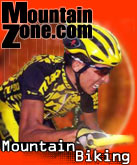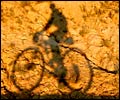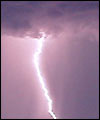
 Me and My Shadow |
||
The Great Divide Mountain Bike Route
September 28, 2001— Great Divide
Created a few years ago by the Adventure Cycling Association, the GDMBR repeatedly crosses the Continental Divide from the US/Canada border in Montana to the New Mexico/Mexico border, covering 2,500 miles through five states. In 1999 John Stamstad completed the entire route in a record 18 days, five hours, creating the benchmark that still stands.
"...the route traversed a
total of 10 major passes, with the highest topping out at 11,990'." |
Patrick Irwin was among the first to attempt a single-state speed record on the GDMBR, but his cross-Montana time trial was cut short by massive forest fires. Later that summer, talk surfaced of a race covering the length of the GDMBR. Equipment and maps were purchased and training plans were implemented, but the race never came to fruition.
While the race was postponed, my interest in it was not. I decided to attempt a time trial from Wyoming to New Mexico, 544 miles through Colorado.
The route wound through modern boomtowns like Steamboat Springs, Silverthorne, and Breckenridge, while also passing through those of yesteryear, such as Radium, Como, and Summitville. The trail traversed through the Elkhead Mountains, Gore Range, Williams Fork Mountains, Mosquito Range, Sawatch Range, Cochetopa Hills, La Garita Mountains, and the massive San Juans.
I hadn't planned to sleep at all the first night, but a waist-deep stream crossing at 3am changed that. I had descended off Lynx Pass, crossed a highway, and a few miles later came to this stream swollen from the afternoon monsoon. Combined with the ambient air temperature of 29 degrees, it presented a colossal stumbling block for me. Were I to wade through it I could expect to break into uncontrollable shivers on the other side while frantically trying to get a fire going with whatever sodden wood I might be able to find. Or, according to the maps, there was an alternate route that would circumvent the crossing with a climb up most of Gore Pass. Neither looked inviting. I couldn't help but note that if I had started a few hours later I would have been here in daylight, which might have made it a non-issue. There's that timing thing again...
I rolled out my bivy gear and climbed in, calculating as I passed out that I'd ridden 107 miles of dirt in the last 10 hours, 45 minutes, including downtime to futz with the bike, decipher route instructions, and restock food in Steamboat. When I awoke at first light I still couldn't convince myself to willingly wade into the fast, deep water. I turned around and climbed the extra miles on the alternate route up Gore Pass, glad at least to be dry.
Throughout the ride I traveled unsupported, carrying all survival and bivouac gear as well as food, water, and lighting. One of the skills crucial to completing an event like this is deciding what to carry (and how to carry it) and what is better left behind. Excess gear doesn't just weigh you down, it increases the frequency with which you stop to fuss with it, thus imparting a bad attitude as well. I limited my gear to a sleeping bag and pad, bivy sack, rain jacket and pants, a water filter and some small personal items like Neosporin, Naproxen, toothbrush and paste, and toilet paper. Total bike weight with gear was about 31 pounds.
That which makes me a terrible short course racer is a blessing in this event: body mass. Possessing a little extra insulation allows me to leave the extra layers of clothing at home, and it also affords a little leeway with food consumption. Skinny guys bonk more easily if they stop shoveling food into their mouths. I don't usually have that problem. Throughout the ride I ate casually from each of the four food groups: Clif Bars, gummy worms, turkey jerky and ice cream. When I'd encounter a town on the route that had a gas station, I'd stock up on all of the above, snarfing a drumstick or one of those savory chocolate chip cookie ice cream sandwiches as I rolled out of town and back onto the trail.
In what became a pattern throughout the trip, I'd make good time in the lowlands between the towns and the mountain passes, only to have to sit and hide under the marginal protection of clustered juniper and sage while lightning strafed the ridge to which I was heading. I'd bide my time by eating or lubing the chain until the charged cloud had passed, then literally sprint the remaining miles to get over the top before the next one could move in. I couldn't seem to buy a break—this went on through the afternoon and into the wee hours each night. Shoulda started a day later.
If there hadn't been so many passes, the lightning would have been only a minor inconvenience, but starting with 9,000-foot Lynx Pass in the north and finishing with 10,230-foot La Manga Pass in the south, the route traversed a total of 10 major passes, with the highest topping out at 11,990'. I swear there was a storm parked on top of each. Also of note is that the route climbed dozens of lower watershed divides that don't show up on the maps. My knees insist that these were no less important.
In most multi-day events it's possible to ride around the clock for two or three days, alternately fighting and enjoying psychedelic hallucinations (brought on by sleep deprivation) through the dark hours and sometimes even in the light. On the GDMBR I couldn't do it. I'd get to the point where I was so stiff, sore and completely exhausted that I had to stop, even though I wasn't sleepy or even close to hallucinating. After having ridden all day and through most of the damp, chilled night, I'd crawl into my sleeping bag for a measly few hours of recharging. While I was warm and dry in there, I can't honestly say that I slept, for I could never find a position that afforded any relief to my throbbing knees.
Prior to starting I'd heard rumors of the massive amounts of climbing involved on the GDMBR, but had seen no reliable numbers quantifying the elevation gain. The only proof I needed was enough to make me mega-dose on the Naproxen in hopes of limiting the damage. The aching in my knees also elicited a vow (with crossed fingers) to sell my single speed if I ever saw it again.
When I'd finally realize that sleep wasn't in the cards, I'd repack my gear in the pre-dawn gloom, then alternately walk and jog the first mile or so to get some blood moving. I'd eventually remount the bike, immediately stopping again to apply skin lube to the, ahem, "contact points" between the saddle and my sore derriere. A short while later the light show of the sunrise would begin, bringing with it a rise in my spirits and an acute understanding of why ancient cultures worshipped el sol. An ancillary benefit was that I could begin to feel my fingers and toes again as the temperature popped back above freezing. Only then did I stop reminding myself of what a dolt I'd been for purposely leaving warm gloves at home.
In the time that I wasn't staring at the route map or cursing my malfunctioning odometer (it kept resetting itself), I simply basked in the warmth of the low angle light, reminding myself that this beat the hell out of any day at work.
I'd borrowed the bike strictly because it had 29" wheels, which roll much more comfortably on dirt (not to mention faster) than their smaller brethren. An added bonus was the soopah-comfy titanium frame and fork. What this bike and wheels did to erase washboard and mitigate other small bumps must be felt to be believed; no suspension system comes close.
Unfortunately, the bike was a bit big for me, a fact I tried to accommodate by using a shorter stem. Actually I used a sizing stem, reasoning that as the race wore on and my muscles shortened I'd be able to adjust the riding position to remain comfortable. Great in theory, but that damned stem kept coming loose on steep descents, suddenly dropping about four inches without warning. I'd fight to regain control of the bike, then frantically search for the brake levers (which were now behind the bars) to haul it to a stop. I'd check my shorts for unsightly leaks, catch my breath, and then dig out the wrench to put the stem back where it was supposed to be.
I had installed aero bars a few days prior to the start with the intention of learning to use them as the ride progressed. While the learning curve was steep, I eventually got comfortable with the low, outstretched position on jeep roads and some doubletracks. Any time there was a smooth stretch of track ahead, I'd lean forward onto the aero bars and watch my speed instantly jump over a mile per hour faster. This never ceased to entertain me. Grinding along on a constant grade with a quartering wind, I'd switch positions frequently to familiarize myself with the degree of benefit each afforded, as told by the cyclometer, and also to find the most efficient position.
"Suffering directly into the
30mph headwind, sitting in a normal position I was able to achieve a
whopping 3.8mph in my middle ring, big cog." |
On the dawn of the third day it struck me how much time is spent not riding during this type of race. Between time spent scouring the aisles of convenience stores for calorically dense food, time spent at a standstill trying to interpret cryptic route instructions, time spent filtering water from streams, adding layers for rain and then restowing them when it stopped, plus all of the time spent waiting for storms to pass, it started to feel like I was touring instead of racing. My average speed verified my efforts, but it was hard not to get paranoid about all the time that I wasn't pushing the pedals.
 Light Show
Light Show | |
That 23 miles of climbing lasted five hours, followed by the inconceivable: the cold headwind actually increased on the descent. I found myself pushing the same gear down the mountain that had gotten me up it. I also frustrated myself to no end by expecting the ride from the top of the 12,000-foot pass to be a long descent. I'm not sure I've ever pushed so hard or climbed so much to get down a trail before. Maybe I should have started a day earlier to miss this @#&%!!! wind.
I stopped briefly in Platoro for a can of stale Pringles and some route info, then continued dodging lightning, hail, and snow as I pedaled the last 38 miles to the border. I stopped again in a small community at the base of La Manga Pass to call a friend who had agreed to come and fetch me from the border and then return me to his house for a meal and some real sleep. For the fifth time in two days, the result of the call was the same: no answer. As I spun up the pass, stopping to wait out the by now customary electrical storm in progress near the top, I shook my head and resigned myself to the idea of spending another night out before I could start hitching the 400 miles home the next day. I also resigned myself to the fact that some people's "word" isn't worth much.
A few minutes before 10pm on Thursday, September 6th, I rolled across a cattle guard and into New Mexico, completing the time trial in just shy of 78 hours. I snapped a photo to document the finish, and then sprinted back a few miles to a thick stand of spruce. I unrolled my bivy gear under the protection of the big trees just as another electrical storm swept through the valley. The incessant lightning was no match for my exhaustion; I passed out immediately and slept for 10 hours.
The next morning, as I packed my gear to start hitchhiking home, I noticed that the high peaks ringing the valley were blanketed with the first real snow of the season. Maybe my timing wasn't so bad after all.
— Mike Curiak, MountainZone.com Correspondent
Mike Curiak's accomplishments include being the first to single-speed the Leadville 100 (he held the course record for two years), numerous 12- and 24-hour race wins, and setting a World Record on the 1100-mile Iditasport Impossible winter race across Alaska. Even more impressive, on a bet he once consumed four pints of Ben & Jerry's in 40 minutes. Between races he enjoys sleeping. And eating.
